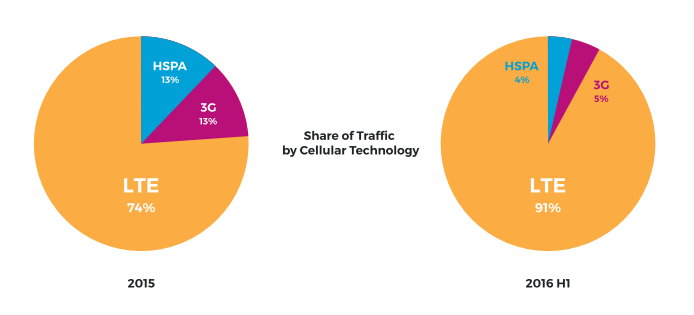 |
| Source: TwinPrime |
T-Mobile US had the fastest 4G mobile network speeds, according to an analysis by TwinPrime, meaning T-Mobile US got access to the network faster, and could download content faster.
T-Mobile US also had the lowest 4G network latency performance, at an average of 52 milliseconds, followed by Sprint at 55 milliseconds, and Verizon Wireless and AT&T Mobility both at 56 milliseconds.
Verizon Wireless ranked highest in terms of LTE network reach, covering 95.3 percent of the U.S. population, compared with 91.7 percent for T-Mobile US, 91.2 percent for Sprint and 91 percent for AT&T Mobility.
As eventually happens as networks become more-heavily loaded, performance is showing signs of strain. LTE 4G networks now carry 91 percent of total U.S. mobile traffic.
The study found median LTE performance in most U.S. cities has dropped by 40 percent to 50 percent compared to our previous report. This staggering drop in performance could partly be explained by the increased LTE traffic share in these cities, or an increase in overall mobile data consumed by LTE devices.
 |
| Source: TwinPrime |
Furthermore, the study also found that Wi-Fi tends to outperform LTE in every major city in the United States by a factor of two. In real user conditions, that translates to it being twice as fast to use an app over Wifi than over LTE.
That is a return to the situation that used to hold for 3G mobile networks, when Wi-Fi often was used because Wi-Fi was faster than 3G. Other tests had been showing that LTE 4G network access speeds outperformed Wi-Fi.
If you want to know why mobile operators argue they need more spectrum, the TwinPrime tests provide the answer.
Traffic is growing fast enough that performance now is visibly degraded. That same pressure is why small cell architectures are deemed strategic: small cells allow networks to reuse more of any amount of available spectrum.
Those same concerns drive interest in shared spectrum, bonding mobile and Wi-Fi spectrum, and LTE 4G networks accessing Wi-Fi directly.
The study includes over 6 billion data points collected from 600 apps with traffic across the United States, India and Europe, more than 1,500 different network operators and 2G, 3G, HSPA, HSPA-PLus, LTE and Wi-Fi networks.
